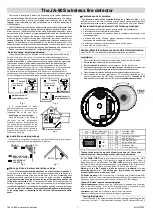
23
24
L
E
It takes longer time to test capacitive loads, and the display readings may gradually increase or become unstable.
When the TEST button is pressed right after the completion of a test, the next test may not be performed
immediately. Wait a few seconds and press the TEST button again for measurement.
In the insulation resistance test, output of the EARTH and GUARD terminals is positive voltage (+), while
output of the LINE terminal is negative voltage (-).
Do not extend the test leads for use, or it may affect measurement accuracy or impair safety.
When measuring high resistance above 1T
Ω
, the Part A of the test probe indicated in the below illustration
should not be touched with the things other than the measured object. In case that such a contact is unavoidable,
use something with high insulation resistance like foamed plastic as a cushion.
In the measurement without connecting the test leads to the measured object, the over range indication,
e.g. ">10TΩ" (at 10kV
, 12kV range), may not be displayed. It is likely caused in high humidity environments
due to current leaked at unexpected points other than the measured object owing to applying high voltage.
In the insulation resistance test, when short/open circuit between the LINE and EARTH (GUARD) is operated
repeatedly or the measured object is broken down by high voltage and starts arc discharge, it may not be
able to test normally due to influence of variations in the strong electric field or interference caused at
discharging energy stored in capacitors. In this case, restart the tester to test again.
The voltage monitor may indicate 10V to 500V instead of 0V when short-circuiting the red test probe and
black test lead in outputting voltage. In this case, voltage applied to the resistors mounted in the testing
circuit of the tester is included.
8.2.5 Voltage Measurement (Check of Power Failure)
Press the DCV/ACV button to switch to voltage measurement, and connect the test leads as shown in
Picture 13.
No need to press the TEST button to start voltage measurement. When the measured object is charged, the
voltage will be directly displayed on the LCD, as shown in Picture 14 or Picture 15.
The tester is equipped with AC/DC auto-detect circuit and can measure AC/DC voltage automatically. In DC
voltage measurement, when positive voltage is applied to the red test probe, positive values are displayed
on the LCD.
Picture 13
存 储
G9312 User Manual
G9312 User Manual







































